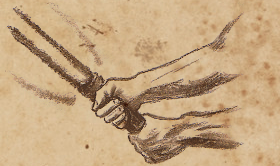| Shii-Cho |
 |
Buzzwords:
- Aggressive
- Blunt
- Hammering
- Direct
- Forceful
- Bullish
- Offensive
- Overbearing
- Raw
- Straightforward
- Unsubtle
- Fundamental
|
Notable Adherents:
|
|
Description:
Shii-Cho is often known by its moniker of "The Simplest Form" . Some in the Brotherhood use the term derisively, seeing the First Form as something learned only by those who lack the skill to learn anything better. True masters, however, embrace the term, seeing the appellation for the high praise it truly is. Shii-Cho is indeed the simplest of the Forms, surviving the ages on the merits of its intuitive ease and obvious utility. While not ideal for every situation, practitioners of Shii-Cho rarely find themselves at a significant disadvantage. Easy to learn though the style may be, masters are to be underestimated only at great peril to one's dignity and possibly, life.
|
|
Grip and Stance:
Shii-Cho utilizes what is called a "hammer grip” where the hands are kept in direct line with the wrists and forearms. Adherents of Form I typically utilize a two-handed grip to maximize their strength. Some especially strong and confident users may opt to use the Form one-handed, either to more easily combine other styles of combat.
The Shii-Cho user will usually bend their knees, legs slightly wider than the shoulders, both to help with balance and to Form a compact target. The saber will be held in a slightly upwards angle, with the grip roughly at waist level. Adherents usually do not so much walk as shuffle across the floor, with the torso and saber moving to keep facing the opponent.
|
|
Movement:
Shii-Cho strikes are direct, straight-line maneuvers that eschew subtlety for the quickest and shortest path of attack. The adherent will commonly strike from the shoulder to put the most weight behind the attack so as to attempt to overpower those foes whose defenses cannot simply be bypassed. The First Form’s attacks show little in the way of variety or obliqueness, and are mostly direct and focused slashes and chops. Its repertoire, though limited, has been known to fool an opponent expecting a more complex attack.
Shii-Cho has no dedicated defensive moves. Instead, its "blocks" are the exact same maneuvers that the style also uses for offense, literally striking an opposing saber blade. This occasionally falters against opponents wielding more than one lightsaber but is otherwise quite efficacious.
|